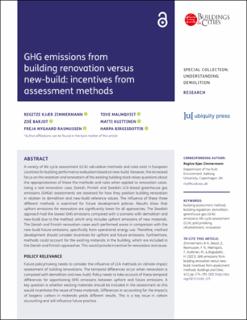| dc.contributor.author | Zimmermann, Regitze Kjær | |
| dc.contributor.author | Barjot, Zoé | |
| dc.contributor.author | Nygaard Rasmussen, Freja | |
| dc.contributor.author | Malmqvist, Tove | |
| dc.contributor.author | Kuittinen, Matti | |
| dc.contributor.author | Birgisdottir, Harpa | |
| dc.date.accessioned | 2023-11-03T09:29:42Z | |
| dc.date.available | 2023-11-03T09:29:42Z | |
| dc.date.created | 2023-07-17T12:42:01Z | |
| dc.date.issued | 2023 | |
| dc.identifier.citation | Buildings & Cities. 2023, 4 (1), 274-291. | en_US |
| dc.identifier.issn | 2632-6655 | |
| dc.identifier.uri | https://hdl.handle.net/11250/3100448 | |
| dc.description.abstract | A variety of life cycle assessment (LCA) calculation methods and rules exist in European countries for building performance evaluation based on new-build. However, the increased focus on the retention and renovation of the existing building stock raises questions about the appropriateness of these the methods and rules when applied to renovation cases. Using a real renovation case, Danish, Finnish and Swedish LCA-based greenhouse gas emissions (GHGe) assessments are assessed for how they position building renovation in relation to demolition and new-build reference values. The influence of these three different methods is examined for future development policies. Results show that upfront emissions for renovation are significantly lower for all approaches. The Swedish approach had the lowest GHG emissions compared with a scenario with demolition and new-build due to the method, which only includes upfront emissions of new materials. The Danish and Finnish renovation cases each performed worse in comparison with the new-build future emissions, specifically from operational energy use. Therefore, method development should consider incentives for upfront and future emissions. Furthermore, methods could account for the existing materials in the building, which are included in the Danish and Finnish approaches. This would provide incentive for renovation and reuse. | en_US |
| dc.language.iso | eng | en_US |
| dc.publisher | Ubiquity Press | en_US |
| dc.rights | Navngivelse 4.0 Internasjonal | * |
| dc.rights.uri | http://creativecommons.org/licenses/by/4.0/deed.no | * |
| dc.title | GHG emissions from building renovation versus new-build: incentives from assessment methods | en_US |
| dc.title.alternative | GHG emissions from building renovation versus new-build: incentives from assessment methods | en_US |
| dc.type | Peer reviewed | en_US |
| dc.type | Journal article | en_US |
| dc.description.version | publishedVersion | en_US |
| dc.source.pagenumber | 274-291 | en_US |
| dc.source.volume | 4 | en_US |
| dc.source.journal | Buildings & Cities | en_US |
| dc.source.issue | 1 | en_US |
| dc.identifier.doi | 10.5334/bc.325 | |
| dc.identifier.cristin | 2162512 | |
| cristin.ispublished | true | |
| cristin.fulltext | original | |
| cristin.qualitycode | 1 | |

